RCA Broadcast News, January 1954
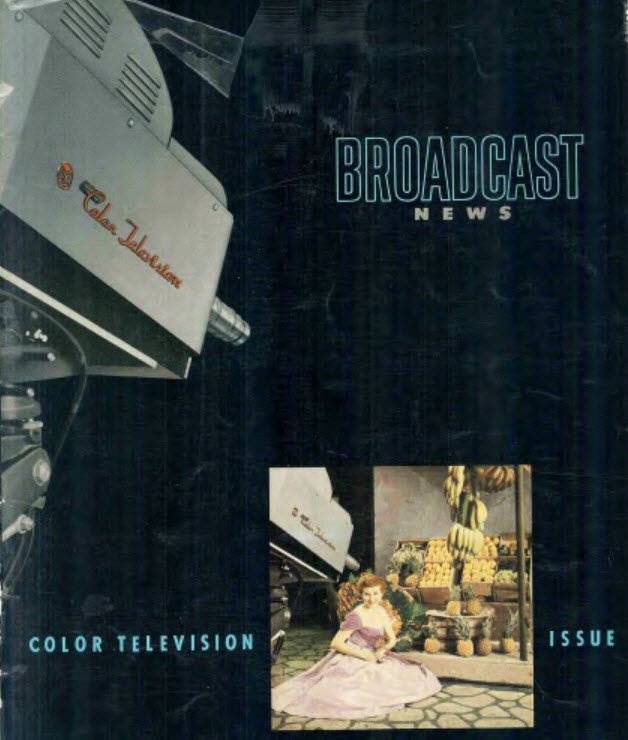
“Color Television – What It Means To Broadcasters” is the tile of this issue, and this was the first issue ever wholly devoted to one subject. That subject is color TV, and this is a fascinating time capsule. On page 62, there is a multipage, photo-filled introduction of the RCA TK40 color camera, but all through this issue, everything color is examined, from film chains to transmission, colorplexers and much more.
November 2, 1959…The Game Show Scandal Breaks Wide Open
November 2, 1959…The Game Show Scandal Breaks Wide Open
It was on this day in 1959 that Charles Van Doren admitted before a congressional committee that he had indeed received the answers to the questions on “Twenty One”.
Here is Herb Stempel discussing loosing to Charles Van Doren by missing the “Marty’ Question. For all of us that have seen the movie “Quiz Show”, you must admit that the movie was very accurate in it’s portrayal of this whole story.
One of the key players in the “Twenty One” story, was producer Dan Enright. At this link is a very interesting and detailed article on Enright’s part, his rise and fall, and his eventual return to television with the shows “Jokers Wild” and “Tic, Tac, Dough”.
http://www.pbs.org/wgbh/amex/quizshow/peopleevents/pande04.html
Actually, “Dotto” with host Jack Narz was the first show to be found rigged, and went off the air in August 1958. Narz was cleared of any wrong doing, but game shows were not, and over a three month period, all were canceled on every network, including “Twenty One”, which last aired October 16, 1958. -Bobby Ellerbee
RCA Broadcast News, April 1961
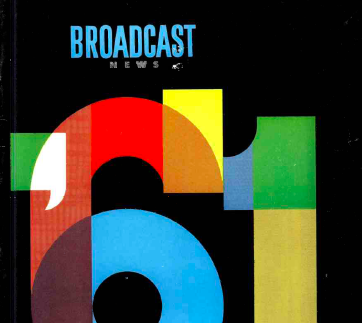
From April 1961, here is what EVERYBODY was doing with color. From networks to local stations and cameras to tape, this packed-with-pictures edition of RCA’s Broadcast News is all about color.
You Won’t Believe Your Eyes! How To Make Miniature TV Studio…
You Won’t Believe Your Eyes! How To Make Miniature TV Studio
A few years back, our friend Jim Wickey made a beautiful, perfectly detailed studio for a real TV show. The RCA TK11 scale models are stunningly realistic, but are made of cardboard. Here are some shots of the finished product, and…his how to instructions. Enjoy! -Bobby Ellerbee
RCA Broadcast News, October 1946
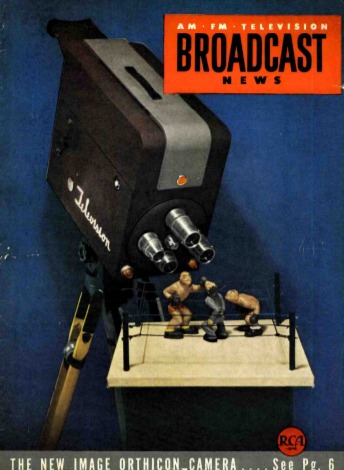
RCA introduces television’s first workhorse…the TK30 Image Orthicon Camera…in a multi-page article. This was the first IO camera, the first camera with a rotatable lens turret, and the first to be mass produced. Many of these cameras were in use all the way up to the time that color finally took over in 1965. On page 20, there is another multipage article on the new RCA Microwave equipment, which was greatly improved and needed to make the TK30 images even better from the field.
October 31, 1953 & 1965…Two Color Television Firsts!
October 31, 1953 & 1965…Two Color Television Firsts!
On October 31, 1953, NBC broadcast the first one hour color program to the full network. The production was a truncated version of the opera, “Carmen”. It was done from NBC/RCA’s only color facility, The Colonial Theater in New York.
At the time, the only color transmitter was an experimental model at WNBT in New York, but the goal was not measure how many people saw it in color…the goal was to measure how well the millions of monochrome sets received the “color compatible” signal.
The cameras used were the four RCA TK40 prototypes. The one hour presentation also included an audio trick or two. In passages where the vocal performance was critical, but extreme movement in dance numbers was too, look-alike actors were subtly inserted on stage to dance and lip synch while the principal operatic stars sang off stage. The principals would quietly return to stage and sing in more static shots.
On October 31, 1965, “The Ed Sullivan Show” debuted in color from its home at CBS Studio 50, with at least four new Norelco PC60s. On a few occasions before this, the show had been colorcast, but those were done from Television City, when the show was visiting the west coast.
18 months later, Studio 50 was re-equipped with Marconi Mark VII color cameras. Hallow Happyween! -Bobby Ellerbee
October 30, 1931…NBC Begins Work On Empire State Tower
October 30, 1931…NBC Begins Work On Empire State Tower
On this day in 1931, NBC began putting a TV transmitter and antenna on top of the Empire State Building. The first experimental TV broadcast from the building was on December 22, 1931.
As you can see in these photos, which were all taken before 1935, there was no tall mast on the building at the time…just kind of a rounded dome. The RCA tower was built on top of that.
RCA’s first experimental television transmissions began in 1928 on station W2XBS located near the Van Cortlandt Park area in the Bronx. Within a year it was moved to the New Amsterdam Theater Building, transmitting 60 line pictures in the new 2-3 mHz band allocated to television.
A 13 inch Felix the Cat figure made of paper mache was placed on a record player turntable and was broadcast using a mechanical scanning disk to a scanning disk receiver. The image received was only 2 inches tall, and the broadcasts lasted about 2 hours per day. By 1930 the station became part of NBC and began to transmit from NBC’s new home at 711 5th Avenue.
The Empire State Building was completed in May of 1931, and RCA leased the 85th floor for a studio and transmitter location for experimental television broadcasts. RCA, through its broadcasting division NBC, applied to the Federal Radio Commission on July 1, 1931 for construction permits for the sight and sound channels of a television station, which were issued on July 24, 1931.
The call sign W2XF was issued in December 1931 for the “sight” channel of that station on an assigned frequency of 44Mc. The RCA transmitter had an input power to the final stage of about 5Kw, giving an estimated power output to the antenna of about 2Kw.
The sound channel of the TV station was separately licensed as W2XK for a 2.5Kw transmitter to operate on 61Mc. Both transmitters were located on the 85th floor and used separate vertical dipole antennas.
In 1936, the tall tower like structure was added as a mooring mast for blimps. The winds proved to be too strong and there were several near accidents in mooring tests, but it did make for a great new antenna mount. -Bobby Ellerbee
EOAG Exclusive Photos…’The Doctors’, NBC Studio 3B
EOAG Exclusive Photos…’The Doctors’, NBC Studio 3B
Thanks to Bob Batsche, and Glenn Mack, we have these these rare color photos that they took on the set in 3B, and thanks to Chuck Snitchler, we have a shot of the slate from the first color episode which would air December 4, 1967, but was taped almost a month before.
On April 1, 1963, ‘The Doctors’ replaced Merv Griffin’s first daytime talk show in the 2:30 time slot, where it remained for nearly sixteen years. This is an extraordinary feat considering the competition, which included long-running favorites such as ‘House Party with Art Linkletter’ on CBS and ABC’s ‘Dating Game’. On occasion, it was also up against one of the longest-running soap operas in television history,’The Guiding Light’ on CBS.
In a move the proved fatal, NBC moved ‘The Doctors’ to 12 noon eastern on March 29, 1982. The show aired its final episode on December 31, 1982, some three months before it would have celebrated its 20th anniversary on NBC.
Frankly, I am stunned that NBC, or any network, would offer any programing at noon on a weekday in the 80s, as there was always a half hour of local news at noon. I have seen a mid 70s CBS daytime schedule that leaves open the 12 – 12:30 block for local programing. I wonder why NBC didn’t do that? Enjoy and share! -Bobby Ellerbee
How The Great Neumann U87 Is Made

How The Great Neumann U87 Is Made…
My favorite mic. Enjoy. -Bobby Ellerbee
https://www.youtube.com/watch?v=cvtjHhtxmpI
Interesting little clip about how a Neumann U87 microphone is manufactured. Pretty fiddly, with a ton of hand labor – no wonder they’re so freaking expensive!
Making Ribbon Microphones…The Detailed Process

Making Ribbon Microphones…The Detailed Process
As a tribute to the sound of the RCA 44, a Pasadena company is making a modern day version, and here is the fascinating process. Thanks to Barry Mitchell for the clip. -Bobby Ellerbee
https://www.youtube.com/watch?v=SHkOkqnJjy0
Here’s another excellent “How It’s Made” episode showing the assembly of an AEA ribbon microphone. This mic is almost $4000.
October 25, 1956…NBC’s “Camel New Caravan” Ends
October 25, 1956…NBC’s “Camel New Caravan” Ends
From February 16, 1949 until October 25, 1956, John Cameron Swayze hosted the 15 minute, week night NBC network news broadcast. The show was done from Studio C in the NBC Uptown Studios building on 106th Street, near Park Avenue.
In this photo from 1949, notice a few things. First, the exaggerated angles the cameras used to shoot him, early on. Second, notice the work-around pan heads on the pedestal cameras.
These are first generation pedestals, made for the RCA Iconoscope cameras that fed the camera cable inside the center column. The pan head for those Iconoscope cameras was not suitable for the much heavier RCA TK30s we see here, and the new friction heads and Mitchel style high hat mounts were not the same size as the column. That meant they had to weld a flat piece to the top to the column and attach these three leg mounts, until the new Houston Fearless TD 1 pedestals were put into Studio C.
This was the first NBC news program to use NBC filmed news stories rather than movie newsreels, which is why the NBC Television News Department was also located at the Uptown Studios. In December of 1948, NBC bought the 11 story studio building from Pathe, who had two huge film processing labs just next door. This was done with an eye toward using Pathe as a distribution partner in getting the NBC Kinescopes processed and shipped.
This live anchor news show, that aired at 7:45 weeknights, grew out of a show that started the year before. Launched on February 16, 1948, by NBC, “Camel Newsreel Theater” was a 10-minute program that featured Fox Movietone News newsreels, with John Cameron Swayze providing off camera voice-over for the series.
The following Monday evening, October 29, 1956, “The Camel News Caravan” was replaced by “The Huntley-Brinkley Report”. President Dwight D. Eisenhower had word passed to NBC’s White House correspondent that the president was displeased by the switch. Ike later grew to like Chet and David. -Bobby Ellerbee
Computers And Automation vs Manpower And Innovation
Computers And Automation vs Manpower And Innovation
This shot from Houston’s KPRC is a great example of how news graphics were done in the 50s and 60s. Some stations had a nice drum like this, but others had easels, or old music stands. The images were faxed in daily from either AP or UPI. The camera is a GE PC 12, but there is more here than meets the eye.
For the younger generation of broadcasters, this must look like a scene from another world. And, it was another world. Radio and TV stations were owned by individuals that lived in the cities they served, and owners were making money, but profits were not always the holy grail…talented people and skilled staffs were. Those people and their innovations in ideas differentiated stations in a way that has gone the way of this graphics drum, in our cookie cutter media world. -Bobby Ellerbee
The Original Beauty Of The Ed Sullivan Theater…Rare Images…
The Original Beauty Of The Ed Sullivan Theater…Rare Images From 1927
More of the history of the venue is in the original article below. Enjoy and share! -Bobby Ellerbee
Rare Ed Sullivan Theater Photos…1927
I love it that these rare photos are now pouring in! Take a look!
This is the theater as is looked when it was built. It opened in 1927 as The Hammerstein Theater and was designed by architect Herbert Krapp who designed about a dozen of NYC’s most famous theaters. Due to the depression, the theater closed in 1931.
It was taken over by Broadway Billy Rose and became a night club with all the theater seating removed and replaced by tables. In 1936, CBS took a long term lease on the building and converted it to CBS Radio Theater 3 (one of five in NYC). The first radio show from here was “The Major Bowes Amateur Hour”.
In early 1950, the theater was converted to television and became CBS Studio 50. The first broadcast was “Arthur Godfrey’s Talent Scouts” show. Godfrey’s talent show had been on CBS radio for over a year and originated here before the TV conversion. Thanks to Simon Crawshaw and Nick Van Hoogstratten for the rare photos. Enjoy and share! -Bobby Ellerbee
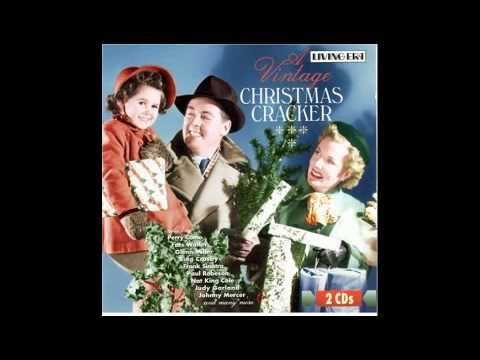
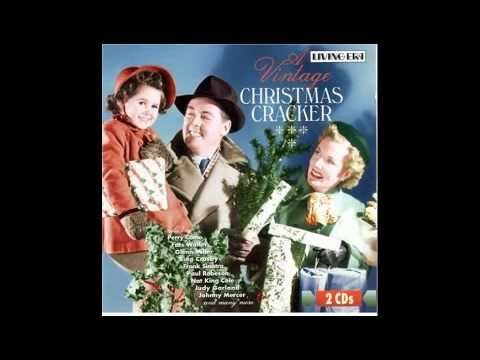
October 24, 1934…”Santa Clause Is Coming To Town”, Recorded
October 24, 1934…”Santa Clause Is Coming To Town”, Recorded
Until broadcast radio and talking pictures came along, there hadn’t really been any “popular” or secular Christmas songs…most were still traditional, religious carols.
The first recorded version of the song was by banjoist Harry Reser and his band, and was done on October 24, 1934 featuring Tom Stacks on vocals. In 1925, Reser found fame as the director for NBC’s Clicquot Club Eskimo Orchestra, continuing with that weekly half-hour until 1935. At the same time, he also led other bands, including Harry Reser and His Six Jumping Jacks, with vocals by Tom Stacks. They were the zany forerunners to comedy bands like Spike Jones and tune was right up Harry’s alley.
“Santa Claus Is Coming To Town”, was first heard live on Eddie Cantor’s NBC radio show in November 1934. It was said that Cantor agreed to introduce this new song (by songwriters J. Fred Coots and Haven Gillespie), because other well-known artists of the time had rejected as being “silly” and “childish.” Cantor liked it, and after the broadcast, the song had overnight orders for 100,000 copies of sheet music, and had sold 400,000 copies by Christmas of that year.
Here it the original version! Enjoy, and let me be the first to wish you a Merry Christmas! -Bobby Ellerbee
https://www.youtube.com/watch?v=kbePb9xNNII
By John Frederick Coots & Haven Gillespie. The first recording of this song. Oct. 24, 1934. New York. from A Vintage Christmas Cracker. Living Era CD AJS 275…
Source
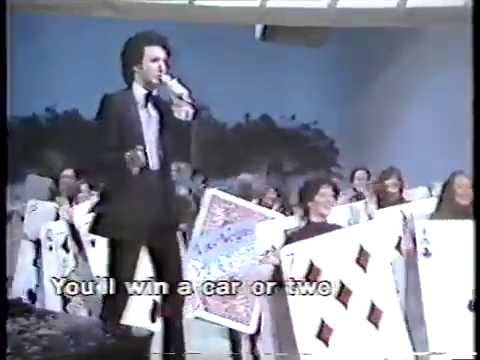

October 24, 1980…Letterman Daytime Show Finale & Studio Tour
October 24, 1980…Letterman Daytime Show Finale & Studio Tour
Classic, Classy Letterman! Last day of his NBC morning show.
Although it only ran from June 23, until October 24, 1980, a lot of what would come later, in the late night years started here, including Stupid Pet Tricks.
From NBC Studio 6A, here is the last 15 minutes of the show, but the first 6 are spent touring the studio and meeting producer Barry Sand, announcer Bill Wendell, director Hal Gurnee, and more, and at the end, a full credit roll with names that are still familiar, like John Pinto, Bill Bonner and Jack Young. The cameras are RCA TK44s.
By the way, near the end, watch for the showgirls in the huge peacock head dresses….if you remember, those were used at the start of the “Late Night With David Letterman” debut show.
Enjoy and share! -Bobby Ellerbee
https://www.youtube.com/watch?v=_z7YGgn-x-0
October 24, 1980. Final Letterman Morning Show excerpts(pt 2 of 2) Live. w.”(Theme from)Las Vegas Gambit Show”( to Theme of David Letterman Show)
Source
October 23, 1956…Videotape Debut Network TV: Setting The Record Straight
October 23, 1956…Videotape Debut Network TV: Setting The Record Straight
Most people think the November 30, 1956 time delayed broadcast of “CBS News With Douglas Edwards” was the first use of videotape on network television. That is not correct, but it was the first use of tape as a time-shifter, in that the east coast broadcast was videotaped at Television City for rebroadcast two hours later to the mountain and west coast time zones.
As for the first known network use of videotape, that happened 60 years ago today at NBC. At the time, “The Jonathan Winters Show” was 4 weeks old. The 15 minute variety show ran from 7:30-7:45 Tuesday nights, just before “The Camel News Caravan” with John Cameron Swayze, replacing one of the two weekly Diana Shore shows that had for years, aired in that slot on Tuesday and Thursday nights.
On October 23, 1956, the NBC engineers in New York wanted to see if the viewing public could tell the difference between a videotape and the live portion of the show. Jonathan’s musical guest that night was Dorothy Collins, of “Your Hit Parade” fame. She had a new record out called “The Italian Theme” and her performance, with dancers and backup singers, was recorded earlier in the day. During the live show, Winters introduced her, as if she was there, and the tape rolled seamlessly. In case there was a problem, NBC had extra operators on duty that night in New York, and to their great relief and amazement, no one called or noticed. With that quiet event, videotape had passed the final acceptance test.
Remember, this is only six months after Ampex introduced videotape at the 1956 NAB in April. In the book “A Companion To American Technology”, Carroll Pursell reports that a month later, in November of ’56, Winters used videotape to play two characters in the same sketch. Unfortunately, there is no kinescope or tape of this historic event either, and about all that’s available from Jonathan’s 1956 show is this single program. Enjoy and share! -Bobby Ellerbee
October 22, 1939…The First Ever Pro Football Telecast
October 22, 1939…The First Ever Pro Football Telecast
77 years ago today, the relationship between professional football and television began when NBC earned a spot in history by televising a pro football game. Only 22 days before, NBC had televised the first ever college game on September 30th.
A crowd of 13,050 were on hand at Brooklyn’s Ebbets Field on that now-historic day when the Philadelphia Eagles fell to Brooklyn’s Dodgers 23-14. Yes, there was a Brooklyn Dodgers football team, from 1930 to 1943.
Five hundred-or-so fortunate New Yorkers who owned television sets witnessed the game in the comfort of their own homes, over NBC’s experimental station W2XBS. Many others saw the telecast on monitors while visiting the RCA Pavilion at the World’s Fair in New York where it was scheduled as a special event.
According to Allen “Skip” Walz, the NBC play-by-play announcer (pictured above), only eight people were needed for the telecast. Walz had none of the visual aids…monitors, screens or spotters used today, and there were just two cameras. One was located in the box seats on the 40-yard line and the other was in the stadium’s mezzanine section.
“I’d sit with my chin on the rail in the mezzanine, and the camera was over my shoulder,” remembered Walz. “I did my own spotting, and when the play moved up and down the field, on punts or kickoffs, I’d point to tell the cameraman what I’d be talking about.”
The television log records of that day say that the game began at 2:30 p.m. and ran for exactly two hours, thirty-three minutes. By comparison today’s games run almost three full hours. Of course there were no commercial interruptions during the 1939 game. There were, however, interruptions of another sort.
“It was a cloudy day, when the sun crept behind the stadium there wasn’t always enough light for the cameras,” according to Walz. “The picture would get darker and darker, and eventually it would go completely blank, and I would begin to call the game in the style I used for radio broadcasts.” Enjoy and Share! -Bobby Ellerbee
October 22, 1962…In The Oval Office For The Cuban Missile Crisis
October 22, 1962…In The Oval Office For The Cuban Missile Crisis
As Told By The Guy In The Red Circle, A MUST READ STORY! From the October 21, 2012 edition of The Savannah Morning News, here is the story in his own words.
______________________________________________________________________________
Barry Ostrow was front and center for the Cuban Missile Crisis Speech! This is the fascinating story of that fateful day…October 22, 1962. Just out of college, he was a brand new hire at WTOP and has a great story to tell! Enjoy and share. -Bobby Ellerbee
My number was up. Some five months after graduation from Ithaca College, my friends and neighbors on the draft board in Poughkeepsie, N.Y., had decided it was time for me to take my pre-induction Army physical. The day designated for my exam at Fort Holabird, Md. – Oct. 22, 1962 – would prove to be not only an emotional personal experience for me but also for the entire nation.
I had been working in Washington, D.C., since June as part of the “management training” program at WTOP-TV, a CBS affiliate, and the CBS News Bureau was located in WTOP’s Broadcast House off Wisconsin Avenue in northwest Washington.
It was a heady time for a young TV production graduate. I was making a whopping $50 a week, but working on loan to CBS more than made up for my penury. From the beginning I served as a floor director for a who’s who of nationally known journalists – Walter Cronkite, Harry Reasoner, Roger Mudd, George Herman, Robert Pierpoint, Marvin Kalb, and bureau chief George Schoenbrun.
On the local news team was an unknown, brash reporter named Sam Donaldson.
Some highlights leading up to Oct. 22 included crewing the expansion of the “CBS Evening News” from 15 minutes to a half hour, an Oval Office taping and news conferences by President John F. Kennedy, and briefly meeting Edward R. Murrow.
On Oct. 21, I was working on the Sunday morning interview show, “Washington Conversation.” The CBS newsroom was buzzing with talk of “something big” going on. Most thought it had to do with the Berlin Wall. The president’s cabinet and the nation’s military leaders reportedly had been spotted entering and leaving the White House, but no one suspected that the brewing crisis was just 90 miles off the tip of Florida.
The next day I rendezvoused with a military bus heading to Fort Holabird, an hour away outside Baltimore. After a morning of filling out forms and some preliminary poking and prodding, our group lined up on the wooden floor of a spare, barracks-like room dressed only in our shorts. As we awaited our next humiliation, a soldier called out, “Is there a Barry Ostrow from CBS in the room?”
As perhaps 30 people looked on, the soldier handed me a telephone. They listened intently to my side of the conversation:
“The White House? How am I supposed to get to the White House? I’m standing here an hour away and half naked in the middle of my draft physical.”
At this point, those in the room began chanting, “Go. Go. Go.”
An Army recruiting officer helped. Within a few minutes, I was in his car speeding down the Baltimore-Washington Parkway. En route, he did his best to convince me that if there was a balloon about to go up, it would be in my best interest to sign up with him on the spot.
The recruiter took me to my apartment on Connecticut Avenue just south of the National Zoo, waited while I changed into a suit and drove me to Broadcast House where he left me with his business card.
I picked up my gear – headphones and a small makeup kit – and hurried out to Wisconsin Avenue to flag down a cab. I always carried the kit with me even though Kennedy was always tanned and freshly shaved. I never had to use it on him. Many politicians, such as Hubert Humphrey and Everett Dirksen, always appreciated a little help with their appearance.
It was now about 3 p.m., and the D.C. rush hour hadn’t begun. A cab picked me up, and a lawyer in the back seat was willing to share a ride downtown. When we arrived at 1600 Pennsylvania Ave., I reached into my jacket for my wallet and discovered I had left it in my apartment.
My co-rider shrugged off the debt, maybe $3, saying, “I think I can trust someone going to the White House.”
He gave me his business card and probably was surprised when a check arrived at his office a couple of weeks later.
Before Dallas in November 1963, it was relatively easy to enter the White House. At a pre-designated gate, the security person had only to check my I.D. against an index card in a small box of approved media credentials. I don’t recall any metal detectors or pat downs.
I caught up with the late Bob Camfiord, the television pool director, outside CBS’ big white remote truck parked near the Rose Garden. Rumors were flying, but no one knew for sure why we were there other than the president would address the nation at 7 p.m.
About 5 p.m., I was ushered down the narrow West Wing hallway outside the office of Pierre Salinger, the president’s press secretary, and into the Oval Office. This wasn’t my first rodeo, but it was always a thrill each time I entered this iconic room. The white curved walls. The blue rug with the presidential seal. The facing white couches and, between them, JFK’s rocking chair.
I sat behind the president’s Resolute desk standing in for him while Camfiord, out in the truck, conducted camera, sound and light checks.
At about 6 p.m. embargoed copies of the president’s speech began to circulate in the West Wing. The topic was not Berlin, but Cuba and the discovery of Soviet missile bases under construction there. Soon those missiles would be operational and pointed at Washington and other U.S. locations only minutes away.
America’s second-youngest president was about to face off with the bellicose Nikita Khrushchev. The doctrine of mutually assured destruction could be tested over a small Caribbean island.
While the imminent prospect of a nuclear war was frightening and heightened by the thought that we were all standing at Ground Zero, there was calmness in the room. Each of us was involved with our immediate responsibilities.
We were not yet privy to the tension that had been building since the missile installations were discovered on Oct. 14 during a U-2 surveillance flight.
The Oval Office began to fill up. In addition to the CBS pool technicians, there were administration officials, at least three news film cameramen and five still photographers.
Shortly before 7 p.m., the president emerged through one of the doors almost hidden in the curve of the office walls. Usually relaxed and casual with the media, this night he appeared tense. I was in my usual position, attached to the camera by my earphones and crouched under the lens directly in front of the president.
At Camfiord’s direction, I raised my arm at 5 seconds before the speech and gave the president a verbal warning. Moments later I pointed in his direction and he began to speak.
Later, in the remote truck, I used the network’s dedicated landline to New York to call my parents. Like so many Americans, especially those in or near major East Coast cities, they were deeply concerned. My mother kept urging me to return home from Washington, but I reminded her that if the missiles should begin to fly, there would be no refuge.
I wish now that I had kept a diary of the ensuing six days of the crisis when the three networks broadcast daily from the White House, the U.S. Department of State, the Pentagon and the headquarters of the Organization of American States.
I remember it as a time of dark remote truck interiors, dark control rooms and dark television studios.
To cover official Washington, CBS brought in Bobby Vitarelli (later, director of the “CBS Evening News”) from New York to work with Camfiord.
They also pressed WTOP-TV’s senior directors Clark Pangle, Bill Linden and Eddie Colbert into service. Remote trucks were at a premium, and I remember Colbert standing outside a station wagon on the White House grounds looking inside at a bank of monitors and directing a stand-up report.
The technicians worked around the clock, sleeping – when they could – on cots at Broadcast House. Working at “golden time pay,” they made thousands of additional dollars that week. Those of us further down the totem pole filled in working as assistant directors and directors.
I readied a lot of film to be rolled and directed a few one-camera cut-ins in the studio with talent like Schoenbrun, Mudd and Kalb. With all of the CBS overtime, I made my first thousand-dollar payday.
As the nation and the world held its collective breath, the crisis played out. Khrushchev blustered, Adlai Stevenson admirably stated the U.S. case in the United Nations, and Kennedy resolutely pursued the naval blockade of Cuba and offered to remove (aging) missiles from Turkey.
And then it was over.
In March 1963, I finally completed my physical at Walter Reed Hospital in Washington, and by August I was in the Fort Carson, Colo., public information office producing mini film documentaries about the base for television stations in Denver and Colorado Springs.
That’s where I heard about the assassination in Dallas, 13 months to the day after Kennedy’s Cuban Missile Crisis speech. The world, of course, was in shock. For me, Nov. 22, 1963, held a particularly personal emotional impact. As I watched the nation grieve, my thoughts were, “I knew him.”
In the ensuing decades, I’ve had many great experiences from the birth of my children and grandchild, to meeting other presidents, to the good fortune of seeing much of the world. But if I had to pick one outstanding time in my life, it would have to be the events of October 1962.
ABOUT BARRY J. OSTROW
Barry J. Ostrow began his career in communications at WTOP-TV where he was on the television production staff working primarily with CBS News. Following Army service with the Armed Forces Korea Network, he worked as a director at WETA-TV in Washington, D.C., and WBZ-TV in Boston.
Later he worked as department head for biomedical communications at Bell & Howell and television division manager for Scientific Communications, both in Chicago. In the cable television industry, he guided television production in the northeast region of TelePrompTer out of Hartsdale, N.Y.
Ostrow spent 31 years guiding communications programs in educational settings, including Richmond, Va., Lee County, Fla., and Savannah-Chatham public schools, South College and Armstrong Atlantic State University.
Since his retirement in January 2010, he has been a freelance writer and continues his passion for international travel.
STATE OF THE ART: The Studio Cameras…A Primer On Innovations
STATE OF THE ART: The Studio Cameras…A Primer On Innovations
The best way to illustrate the current configurations of camera platforms is with this set of images from Conan O’Brien’s “Tonight” show, taken for us by Bruce Oldham, who was Camera 3 with Conan for many years. Below is a typical setup…a Canon DigiSuper studio lens and a Sony HDC 1500 camera, and some interesting mounting as we will explore in detail. Now is the time to look closely if you have never seen this kind of arrangement.

Above is what is now called a “studio buildup kit.” Below is a Sony HDC 1000, and it’s called a “hard body” camera. This is the configuration most of us are familiar with, as this is was the traditional design since there was such a thing as television.

The first departure from the norm came from RCA when they introduced the TK760, which in essence was a ‘hard body’ chassis with an RCA TK76 ENG (Electronic News Gathering) camera inside. The TK76, was their first shoulder mounted color portable, but with in the 760 configuration, the 76 gained a full size box lens and full size viewfinder.
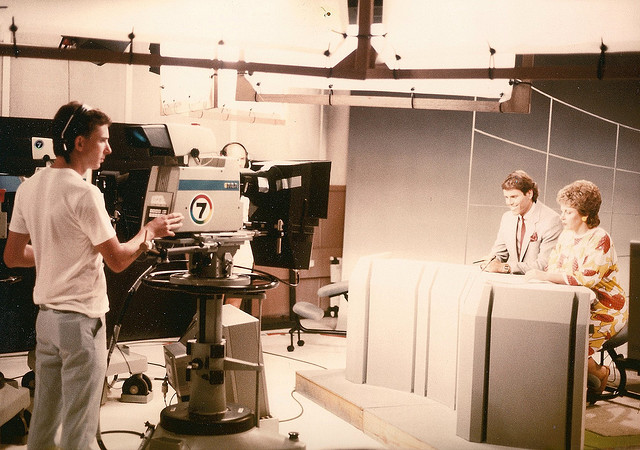
Above, the RCA TK760 with and TK76 inside…below, the RCA TK76. Both cameras have a 1976 vintage.
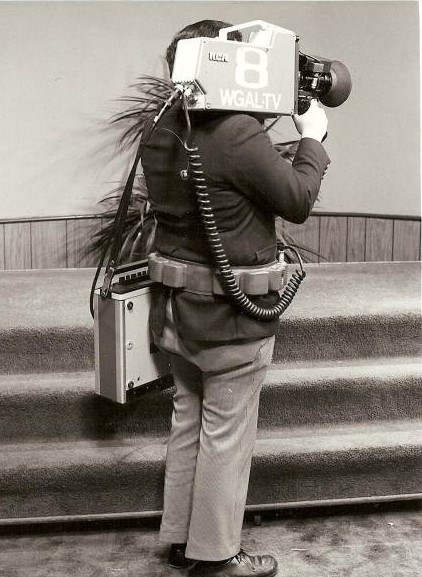

If you haven’t quite caught on yet, this should do the trick. Do you notice the difference in the light and dark parts of the camera? Well, that’s because these are two unique elements. Below, you can see the sled’s back opened up to reveal a small ENG/EFP-size camera inside. In this case, the camera is a Sony HDC 1500.


Okay, here’s what is going on. Above is the Sony HDC 1500 (Hi-Definition Camera) and below is the Sony HDLA 1505. (HDLA means “Hi Definition Lens Adapter.”)

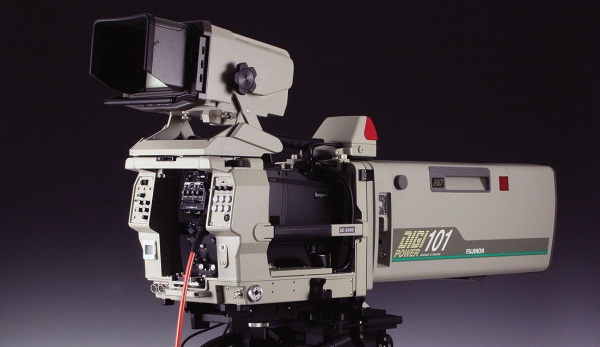
Ikegami has a slightly different version of its build-up kit, called a System Expander. Above is the Ikegami SE S500 in the studio. Below is yours truly behind an Ikegami HDK 79EX III with the SE S500 field configuration. Chuck Pharis took the picture at the University Of Georgia’s Sanford Stadium while I was visiting him at work the day before game day. Below that is the Ikegami HDK 790 EX III hard body camera.
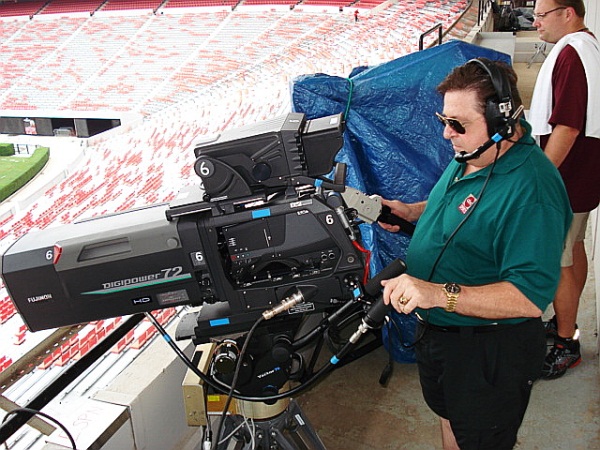


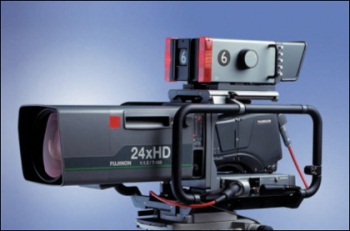
Thomson did something like this in the 1990s and called it a “sled.” One each side, you can see their sled that started as an easy new way to move their big cameras without taking them apart, like the LDK 9. A few years later, Thomson had a better idea, and mounted an ENG camera in the sled as you can see on the right. The arrangement sidesteps the need for ‘hard body’ cameras and allows the small camera to be quickly and easily removed from the large lens adapter for maintenance and repair, or for use in the field or studio as a hand-held with quick addition of a smaller EFP-style lens. Call me old-fashioned, but I still like hard bodies.
Before we go further, let’s talk about ENG and EFP. ENG stands for “Electronic News Gathering” cameras.The term started with the RCA TK76 that debuted in 1976. EFP, which stands for “Electronic Field Production” cameras, is a new manufacturers designation for the same small cameras most of us still refer to as ENGs. I may be wrong, but I think the difference is mostly in the usage. ENG cameras are usually sound-equipped and are used in “stand alone” point-and-shoot, news-gathering situations. EFP cameras have no audio capabilities, are usually used in pairs or threes, and require setup time, cables and switchers.

Above and below are more interesting new technical developments. Above, we see a camera using the standard EFP-style camera lens instead of the large Canon box lens. Below is a great side-by-side comparison shot.

As mentioned above, the camera itself can be used in the studio with the large or small lens configurations. The small lens allows for quick use of the camera as a hand-held medium. In the-hand held mode, the camera’s eye piece viewfinder must be used. When mounted, one of several kinds of large viewfinders can be used with the Sony Large Viewfinder Adapter. This can be seen in the two images below. Upper image is the Sony HDLA1507US catalog image; the real thing is seen just below.



Closer looks at the EFP large viewfinder adapter’s use are above and below. With Sony, when the camera is seated in either the viewfinder adapter or larger lens adapter, the power and controls of the camera are partially transferred to the control panel on the back of the sled, as seen in the image below.


We’ll close with a couple of camera shots that show Bruce’s camera 3 (above) and the main interview set. Below, a full large lens adapter kit was in use next to Andy’s podium; to the right, the smaller EFP camera is naked. It’s just mounted on a light weight ped and ready to go hand-held instantly. Bruce’s camera was one of the three large lens cameras mounted on the new Vinten Quattro peds, and was equipped with a Canon 72X DigiSuper lens. It did guest close-ups at home base and other zones. The other two large lens cameras had Canon 27X DigiSuper lenses and were cameras 1 and 2. All together, there were nine cameras with eight operators in the studio. Cameras 4 and 6 were the combo hand-held and ped-mounted. Camera 5 was the jib, and 7 and 8 were robo-cams with one operator. There were also 2 Iconix lockoff lipstick cameras for audience shots.



How Cartoon Trump/Clinton Come To Life On ‘The Late Show’
How Colbert Does “Live” Interviews With Cartoon Hillary & Donald
New technologies to create live animations are gaining attention this year with the use of Adobe’s Character Animator. The new program can shorten the time to create animations from weeks to hours, by allowing animation puppets to immediately mimic the movements of someone’s lips, shoulders and eyes using a face-tracking camera. Here is the story. -Bobby Ellerbee
https://www.cnet.com/news/cartoon-donald-trump-late-show-stephen-colbert/
How Cartoon Donald Trump comes to life on ‘The Late Show’
Live cartoons of Trump and Clinton could be just the beginning of real-time animations.